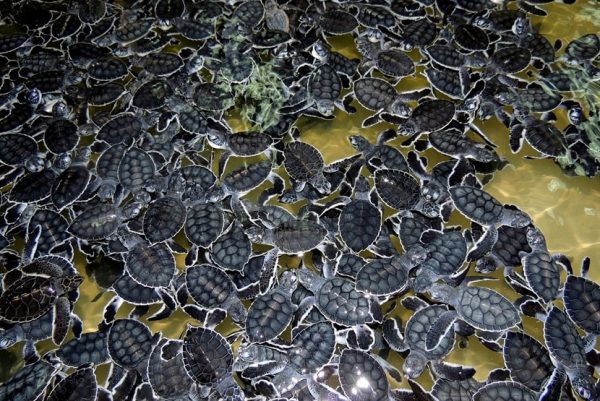“I’m bored with this hole. I think I’ll make another one over there. Oh wait, that’s a better spot.”
It’s turtle time again, meaning that from mid-May to September female turtles dig four-foot-deep holes on the eastern side of Isla Mujeres, leaving the beaches looking like a Bobcat excavator had been at work.
It is a nocturnal activity and the turtles are normally gone well before dawn, but occasionally a female will still be laying eggs at sunrise after having spent too long searching for a perfect nesting site.
One night last July, around midnight, our little four-legged alarm system, Sparky, woke us with a woof. We popped out of bed to investigate the strange noise coming from our oceanside yard. It sounded as if someone was shoveling sand, preparing to bury a body. (You can tell we read a lot of murder mysteries and thrillers.)
With a quick flick of the flashlight we spotted a large sea turtle deep in the bushes on the south side of the house, violently flipping rocks and sand. We wanted to help her find a better spot but decided that she had to make her own decisions about the suitability of the location for her nest. In the end she abandoned the attempt and moved on to another place.

Sea turtle hatchlings prepare to enter the sea at an Isla Mujeres beach. (PHOTO: mexiconewsdaily.com)
Thirty years ago, before the creation of the turtle conservation program and the Isla Mujeres turtle farm, the chances of a turtle egg hatching, and the new babies surviving, were minuscule. Dogs, birds and humans all preyed on the eggs.
If the eggs did hatch then large fish and sea birds would gobble up the delicious hatchlings as they dashed for the ocean. In 2015 Semarnat, the government department responsible for the ocean and shores around Mexico, in conjunction with the local turtle farm, collected a record-breaking 130,000 eggs.
The downside of so much nesting activity is that it is not physically possible to collect all the eggs for hatching at the turtle farm. Last summer we saw at least six large nests that had been re-dug the following night by another mama turtle, which scattered eggs across the beach, crushing the fragile spheres with its large body.
The upside of the extra eggs is that crabs and birds happily feast on the embryos, increasing their chances of producing more baby crabs or baby birds.
Until 2015, Semarnat, the turtle farm and the municipality of Isla Mujeres jointly held several public releases from July into October of recently hatched turtles. Visitors and islanders, especially parents with small children, were invited to help release up to 10,000 babies at a time.
The program was designed to increase the awareness of sea turtles, and to involve the younger generation in the survival of the species. The events always took place at dusk, reducing the risk of predators.
Unfortunately, the voracious seagulls and frigate birds soon learned that a crowd of people on the beach at dusk meant food: lots of food. It was heartbreaking for the participants, especially the little kids, to watch the birds swoop down and gobble up the babies.
There was also some suggestion that people could transmit diseases to the turtles while handling them. In any case, the public events were terminated. We miss excitement of seeing the hatchlings heading off to a new life, but the whole point of the turtle conservation program is to preserve the species, not provide public entertainment.
If you are visiting Isla Mujeres, a stop at the turtle farm is a fun way to learn a bit more about these amazing creatures. The inexpensive entry fee helps maintain the facility.
Living on the eastern side of the island we experience, first-hand, the mamas landscaping our beach in the quest for the perfect nesting site. Love those ladies!
By Lynda and Lawrie Lock
The writers are Canadians who have been full-time residents of Isla Mujeres for nearly 10 years. You can read their blog here.
Source: mexiconewsdaily.com



